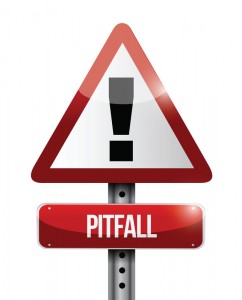7 Leadership Pitfalls That Sabotage Company Growth
What’s sabotaging your growth?
Driving profitable growth is at the top of every leader’s priority list. Yet, according to Bain and Company, only 10% succeed in achieving sustainable profitable growth.
 While growth is the life-blood of every business, at some point, your company will experience the double edge sword of growth.
While growth is the life-blood of every business, at some point, your company will experience the double edge sword of growth.
Either your company will grow faster than your internal capacity to handle it. Chaos, breakdowns and burnout are the result.
OR
Your company hits a wall and growth flattens. As a result, panic often sets in and leaders make rash decisions – either prolonging the stall or causing the company to spiral downward.
Unfortunately, there are no alarms to warn you of either impending challenge. Growth does not follow a linear path. It can be unpredictable and erratic. Growth walls often catch leaders by surprise.
Some companies don’t survive growth walls. They either go out of business or stay in “no man’s land.”
The focus of this article is to address the latter issue – ie., growth walls. While many leaders see growth walls as a revenues issue. The truth is that flat numbers are the byproduct — not the cause — of stalled growth.
The good news is that there are predictable pitfalls and signals that leaders need to heed to scale their companies. This article focuses on 7 of those growth pitfalls.
7 Pitfalls That Stall Your Company Growth
-
Running After Growth in all the Wrong Places
Initially, growth is critical for survival. However, as your company scales, not all growth is healthy or good.
How, as a leader, do you distinguish between good and bad growth? Healthy vs. unhealthy growth?
What % of your new business is coming from your core competencies? What % requires capabilities beyond your core?
Do all your new revenues provide healthy margins? If not, is it a market issue, a competitive issue, a behavioral issue or something else preventing you?
According to Bain, companies leave significant money on table because they are not fully leveraging their core.
Tim Cook (Apple’s CEO) says it best …”At Apple we say ‘no’ to great ideas every day in order to do one or two things very well.”
How much of your new growth focuses on what you do best?
-
Success Blind Spots
Companies that hit a wall have experienced past successful growth. They are meeting or exceeding revenue goals. Their leaders and employees are proud and rightfully so.
However, success often creates cognitive or psychological leadership blind spots. Below are 2 examples how.
- Blind Optimism
You make unconscious assumptions that company growth will continue on the same trajectory if you keep on the path you have been. However, markets change and so must your path to future growth.
- Over-Confidence
Past success can exaggerate your ability to control events. And you over-estimate your company’s capabilities.
When over-confident, leaders tend to take on risky opportunities, not ask for help and believe they can handle it all.
Whose unbiased perspective can you access to right-size your decisions and perceptions?
-
Crashing into the Leadership Glass Ceiling
In my extensive experience with growth companies, the number one reason why companies hit the wall is because their leadership team has hit a wall.
 Organically grown leaders don’t know what they need to know to get to the next level. As a result, they keep on doing what they have always done – only working harder — expecting a different result. Yes … that’s called insanity :))!
Organically grown leaders don’t know what they need to know to get to the next level. As a result, they keep on doing what they have always done – only working harder — expecting a different result. Yes … that’s called insanity :))!
As a company scales, leadership roles also scale and change dramatically at each growth level. To avoid the leadership ceiling, CEOs must ask themselves —
Are you willing to make a major investment in growing your leadership team to the next level?
Does it serve the greater good of your company to be loyal to long time leaders whose roles have outgrown their capabilities and capacities?
Is it time to hire outside seasoned passionate leaders who have been there and can help you grow?
Both options – ie., cultivating your leaders from within or hiring from the outside – have their upsides and downsides.
If your leadership team has hit a ceiling, get outside help in evaluating the options. Doing nothing will keep your company stuck at the wall.
-
External Oblivion
As a company scales, significant focus is spent on building internal infrastructure. As a result, leaders lose sight of changes in their external environment.
A once fringe competitor may now emerge as a looming threat to your company. Your customers’ needs may have changed without you realizing it. New disruptive technologies may displace your products/services as alternative solutions to your markets.
Successful growth leaders who break through the wall anticipate the unexpected and turn the unexpected into the profitable.
Are you overly focused on internal superiority that you are missing the cues of external changes?
How are you proactively anticipating and responding to external changes?
-
Hiring for current skills, not long term capabilities
As a company grows, the tendency is to hire employees with current needed skills by your organization. When small, hiring for the short term is necessary as your resource needs are not always clear.
Once a company hits the $10 – $20 million milestone, hiring people with capabilities to grow your company in next 2 – 3 years is crucial.
What capabilities do you need to hire today to achieve your desired growth for next 3 years?
-
Culture Meltdown
When a company has less than 20 employees, rarely is culture a dominant issue. As the company scales in size, structure and complexity, culture becomes the heart and soul of its growth success.
What causes a culture meltdown as a company scales?
It’s not one thing. It’s multitude of factors that amplify with scale, such as …
- Not Scaling Culture
Some leaders will argue that company culture cannot scale. I both agree and disagree :)).
Your company culture cannot scale if you perceive culture as fixed, unchangeable and static. However, the culture your company needs at $20 million will be different than the culture you need at $50 – $100 million
As you add new people to your organization, as well as your markets evolve, so must your culture evolve.
How are you adapting your culture to the changing needs of your organization and those of your customers?
- Core Values Without Success Measures
While your company’s culture may seem intangible and elusive at times, you can make the intangible tangible and measurable.
The key is to define an abstract value into an operational, measurable success outcome.
I have one client with a core value of excellent customer service. Their measure of success is a customer excellence rating of 25:1. For every 25 customers that rate their service as excellent, only 1 or less customers will rate it as non-excellent.
How do you measure success for each value?
- Healthy Values Gone Bad
Every positive value also has a dark, unhealthy side. However, most leaders are not aware when their values have crossed that line.
A value of excellence, in the extreme, can become perfectionism. Acceptance, at its extreme, can become (unhealthy) tolerance. Customer service, to the extreme, can cost you significant profits.
It’s good to set the bar high. At the other end, know when your values become your Achilles heel, especially as you scale.
-
Mediocrity Sets In
The final danger as companies scale is backsliding into complacency or mediocrity.
Success is a lousy teacher. Complacency often sets in as your company loses its drive and hunger. Nothing will kill growth faster than losing your sense of urgency.
High growth companies should celebrate success. If your company has hit a wall, however, it’s time to take stock.
Has your success morphed into over-comfort and contentment?
If it has, it’s time to raise your bar, set new sights and refuel your organization’s fire. Commit to scaling not only in size. Commit also to scaling big WHY and purpose.
Getting Back on the Growth Track: Initial Steps
- Educate yourself about your company’s growth life cycle and the common pitfalls at different growth stages.
- Get your leaders out of day to day operations.
By the time you hit $15 – $20 million in revenues, your leaders should spend about 80% time leading – building teams, delegating, creating strong culture, focusing on long term goals/projects, etc. – and only 20% on daily operations.
To prepare for the transition, ask yourself:
Do your leaders know how to think strategically?
Are their brains wired for big picture, future-orientation, goals/results thinking?
Do they have strong delegation skills to get out of the weeds?
Remember … not all leaders will be able to make the leap to the next level.
- Invest in infrastructure and systems that provide built-in capacity for growth.
- Get outside perspectives
An advisory board or board of directors … visits to “friendly” competitors to see how they do things … hiring a consultant with experience in growth companies. These are all ways to get beyond your blind spots and tap into expertise that may be missing in your organization.
- Invest in scaling your company culture
Continuously communicate your company’s vision and purpose. Entrench your values and behavior norms at all levels of organization. Change your culture as needed.
- Download our complimentary handout — Developing Leaders of Growth: 5 Critical Factors for Driving Double/Triple Digit Growth




